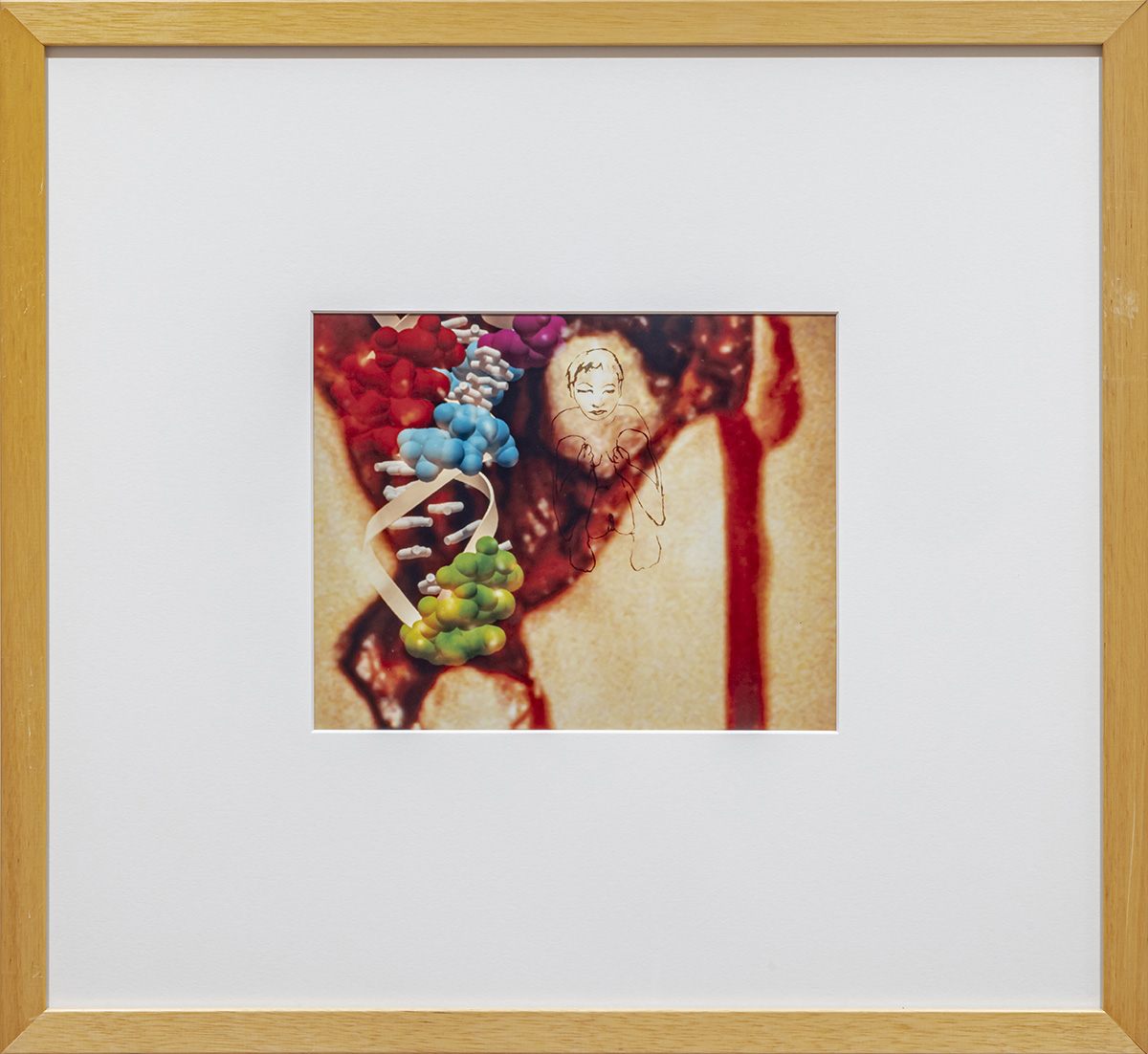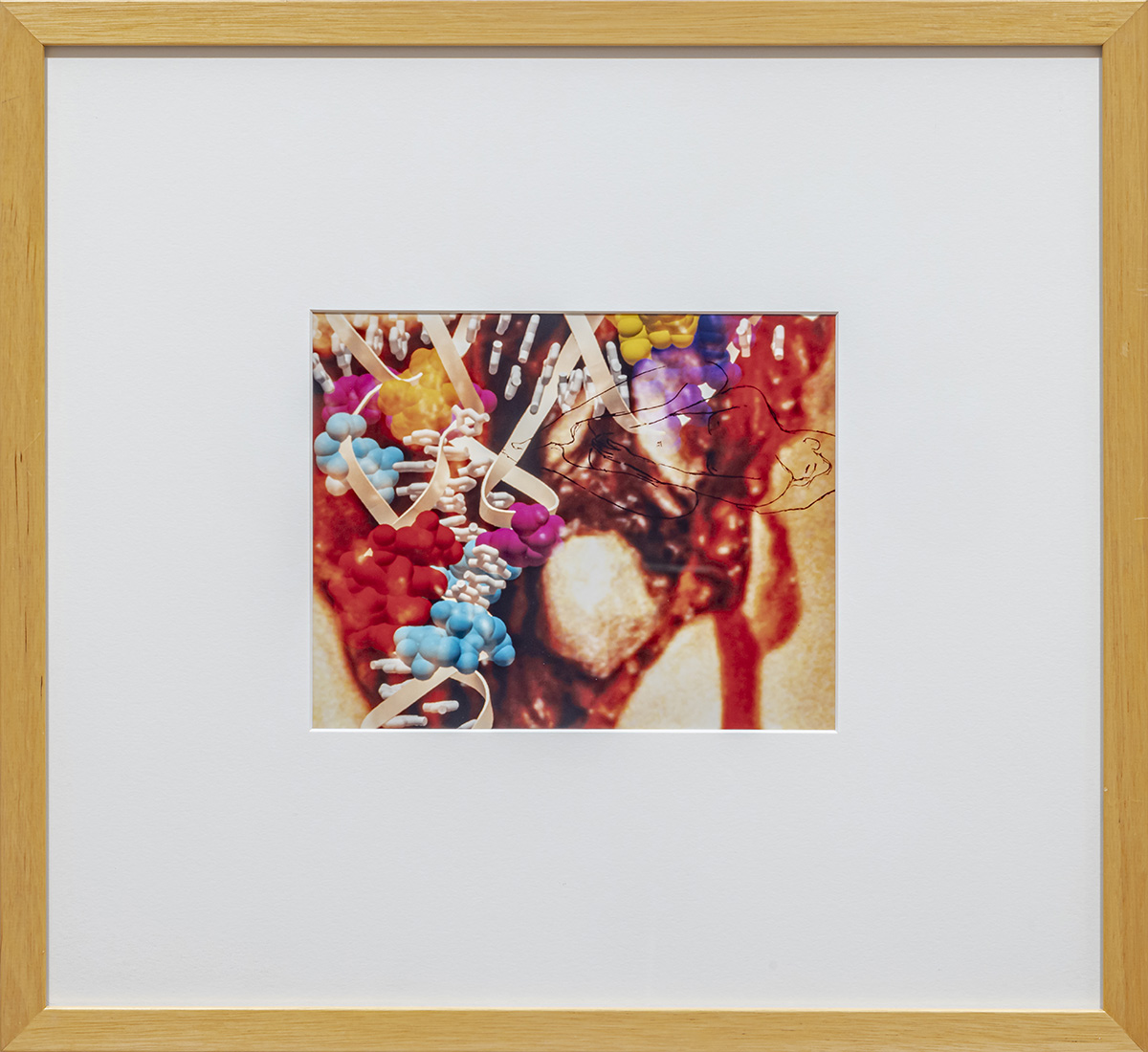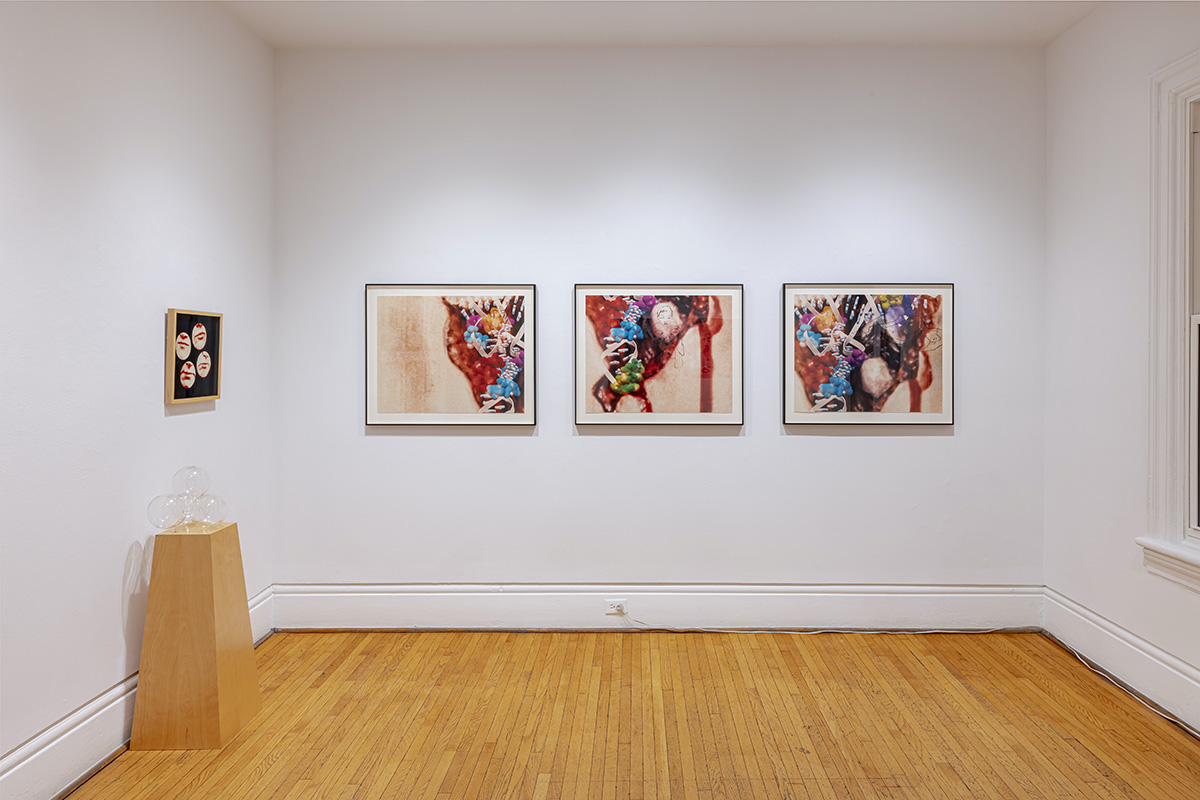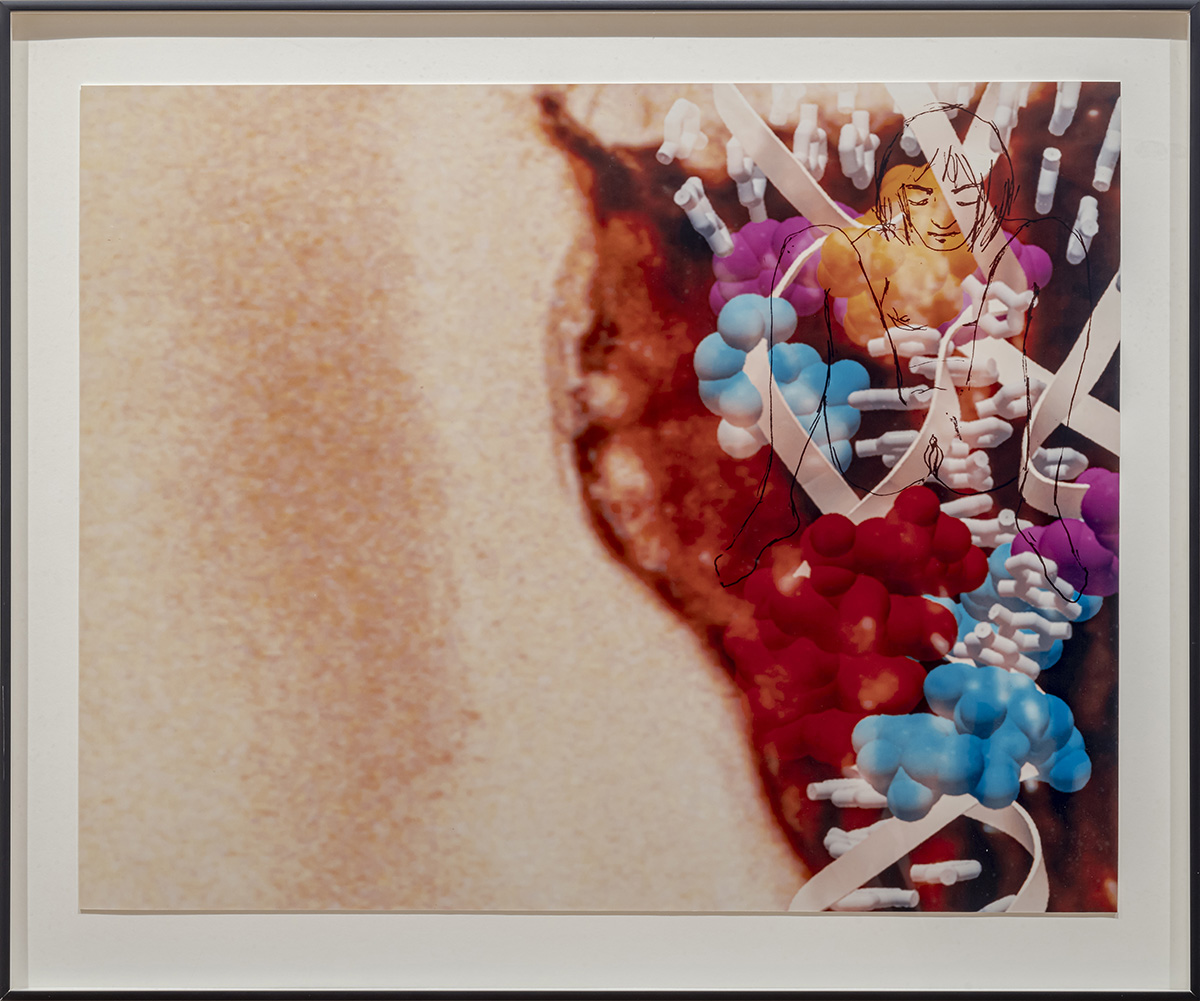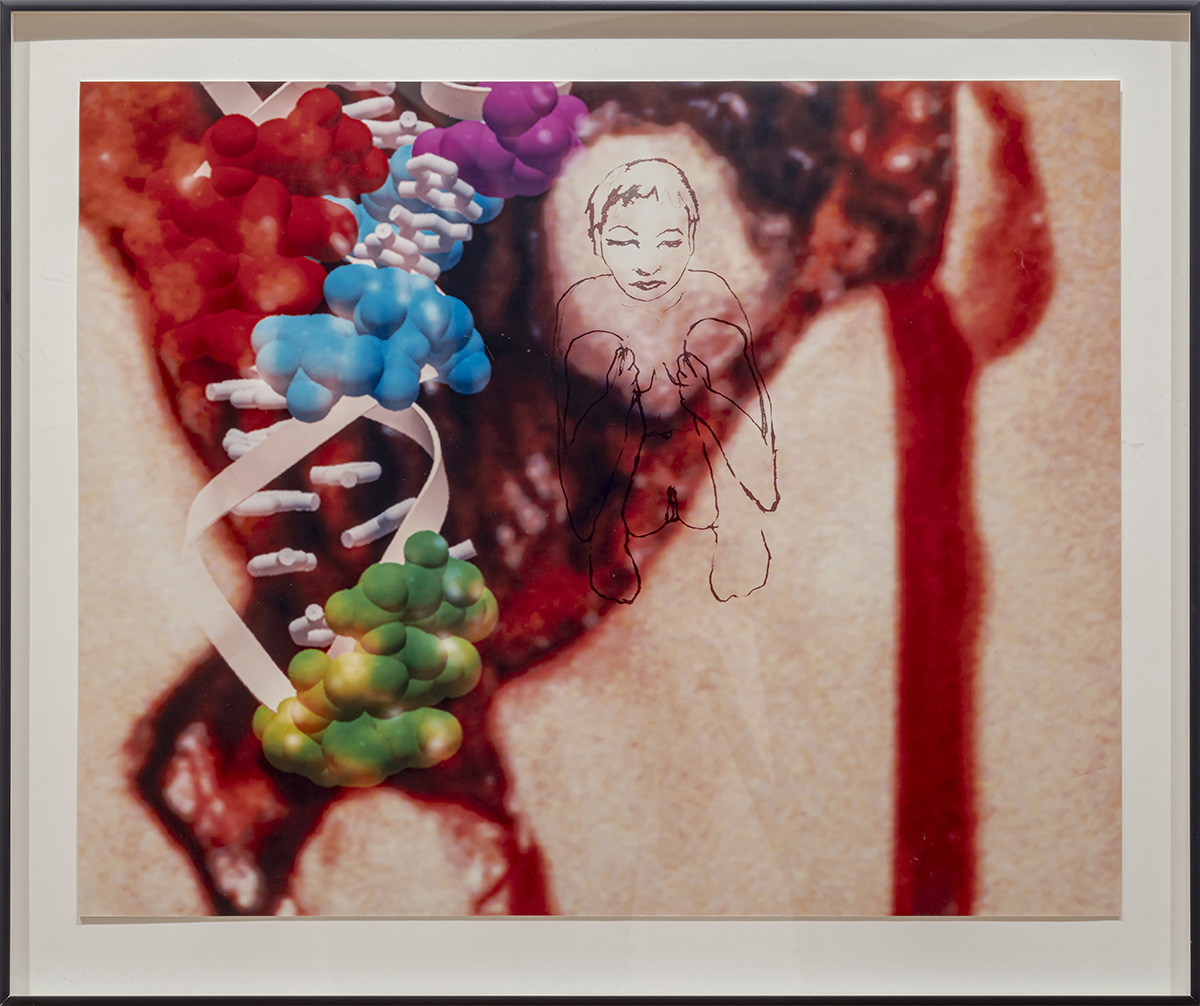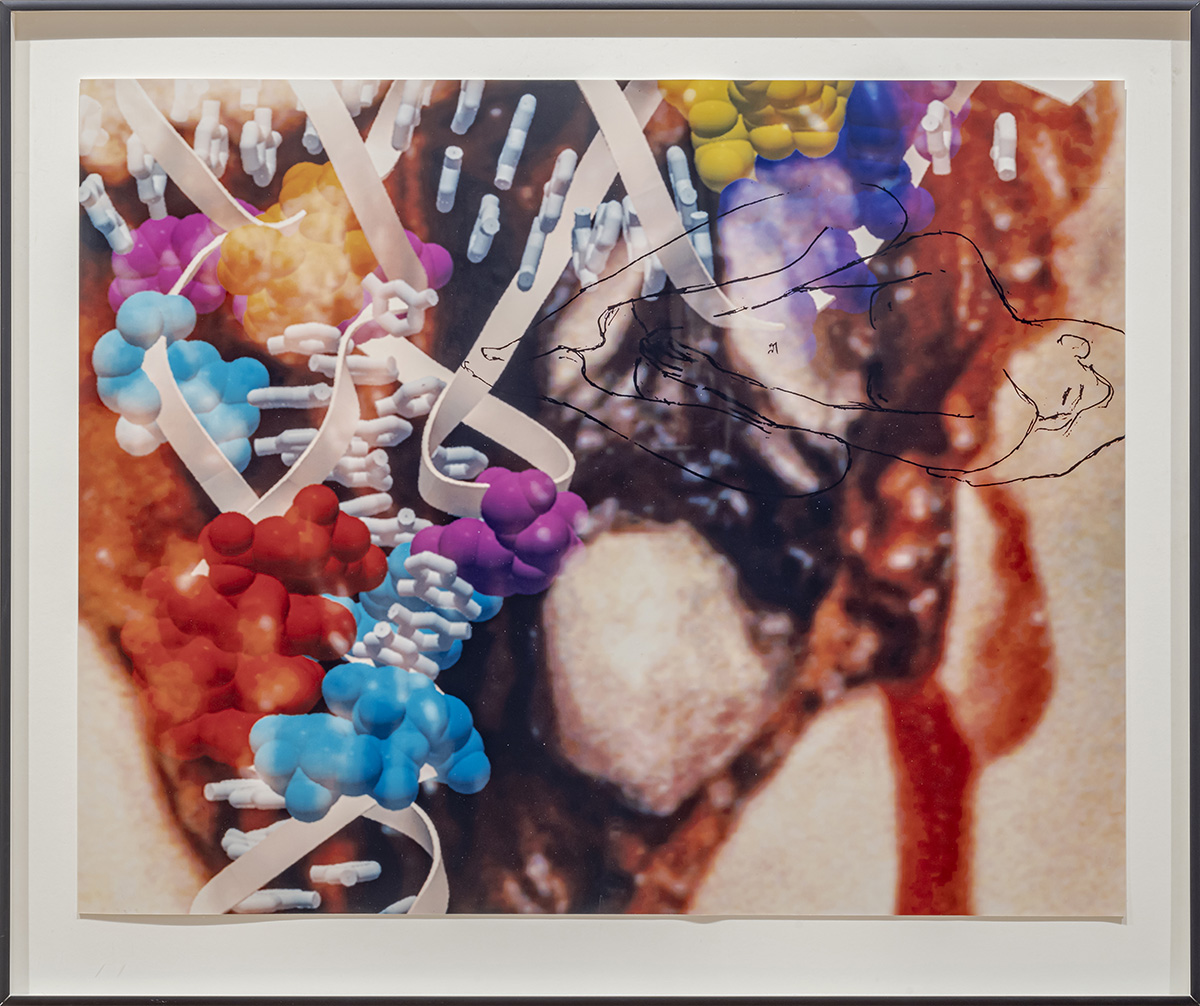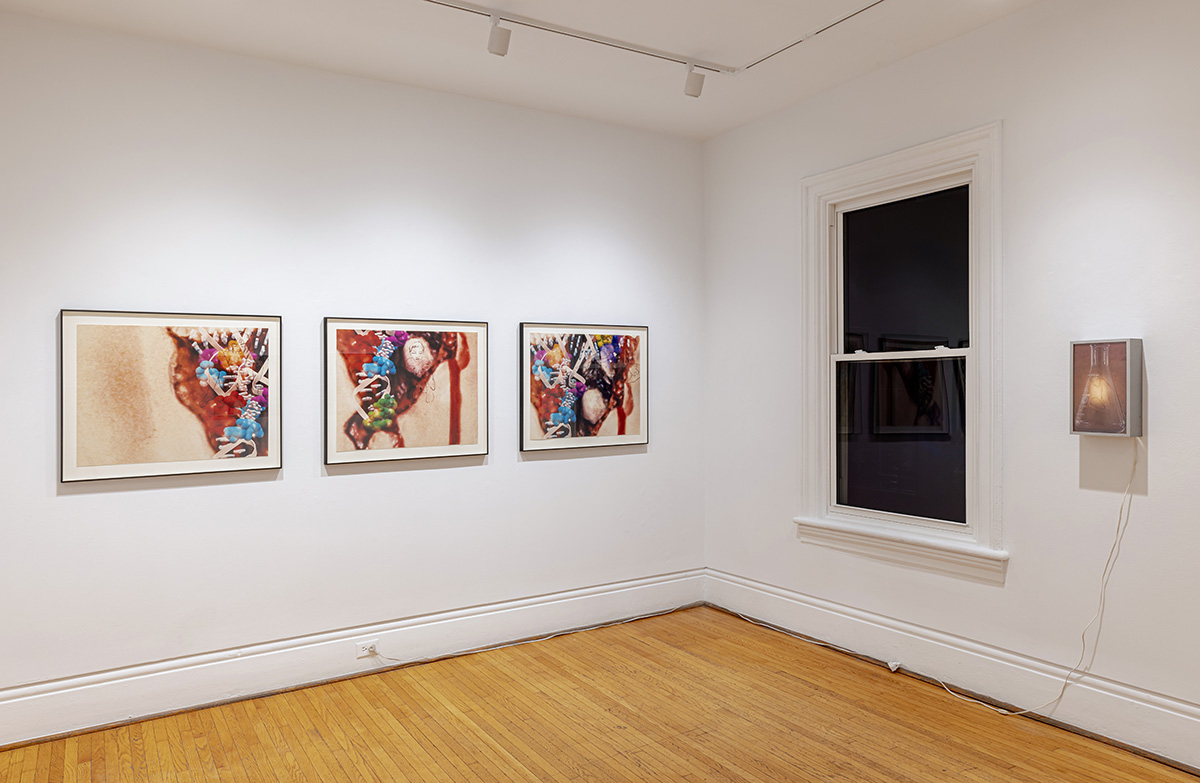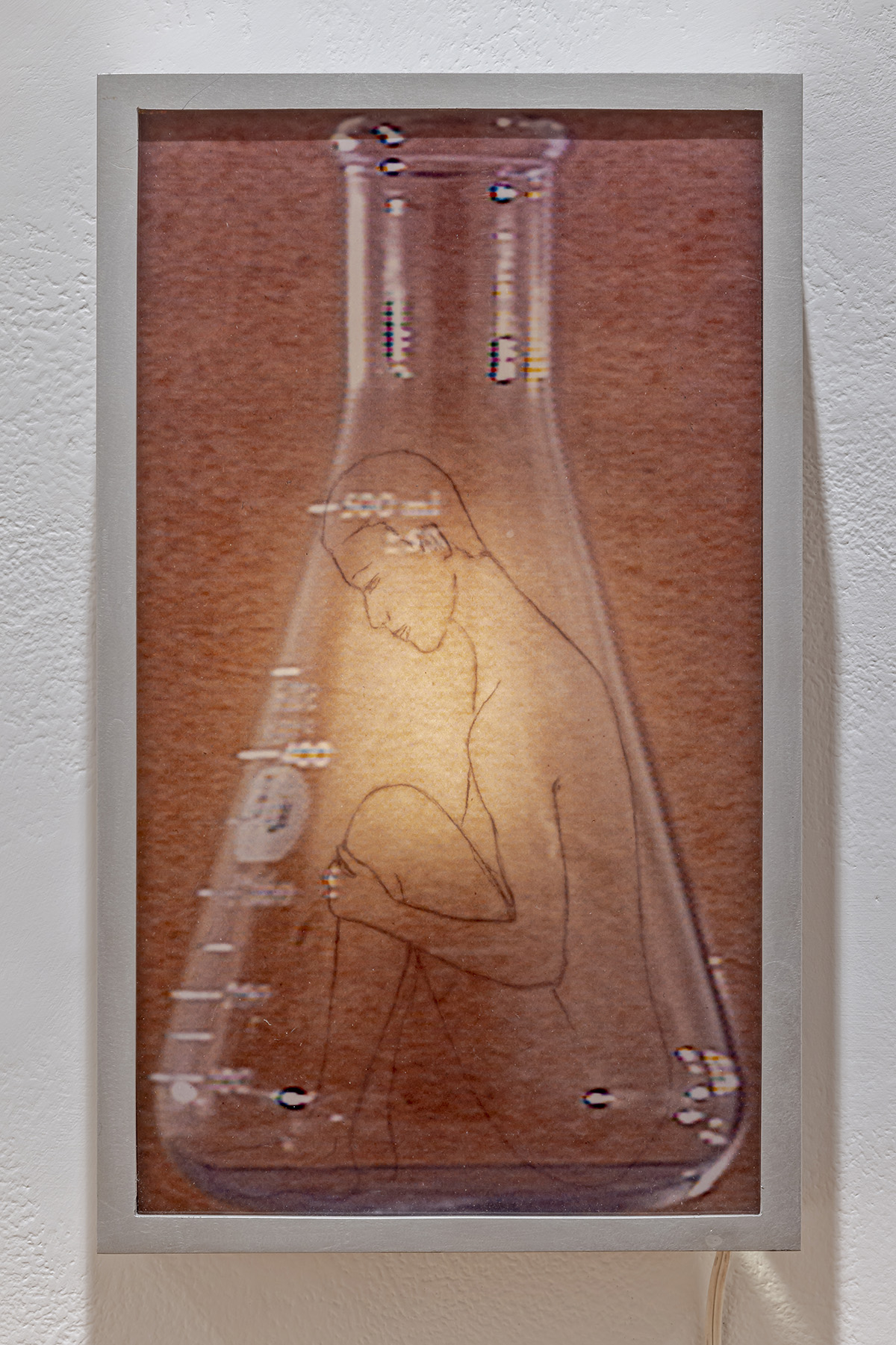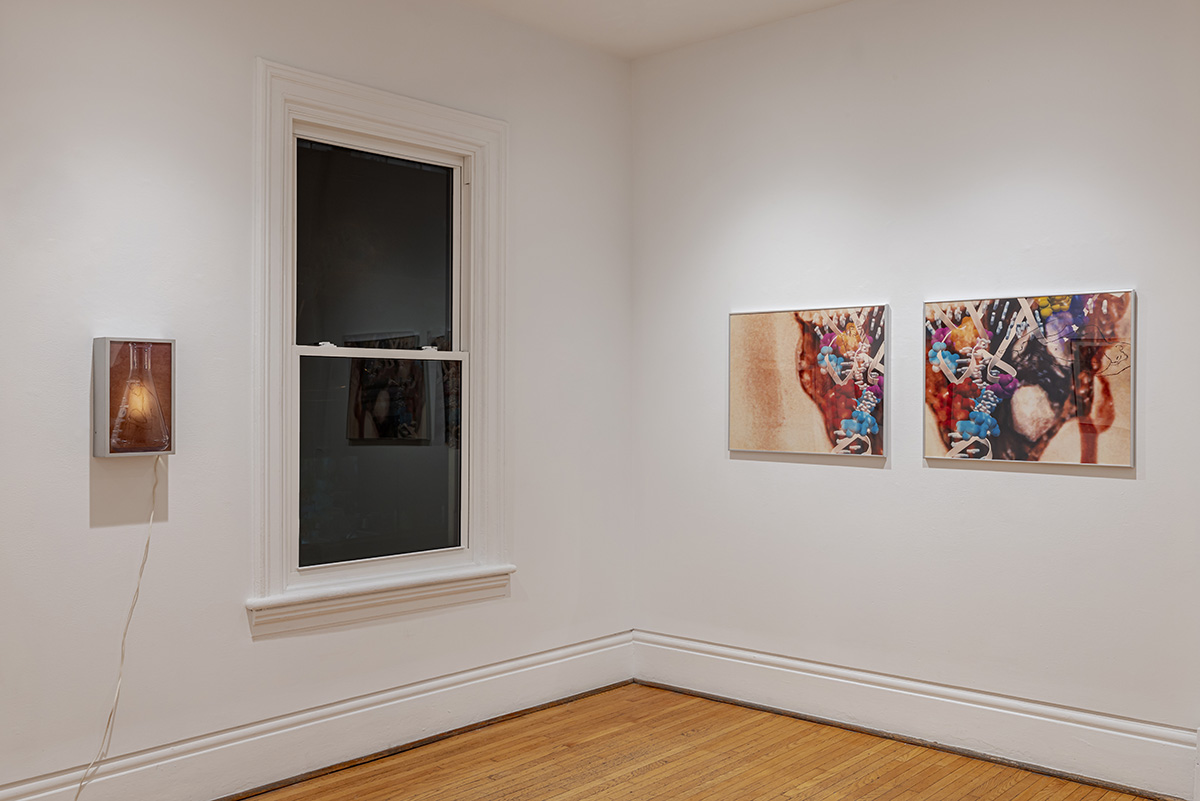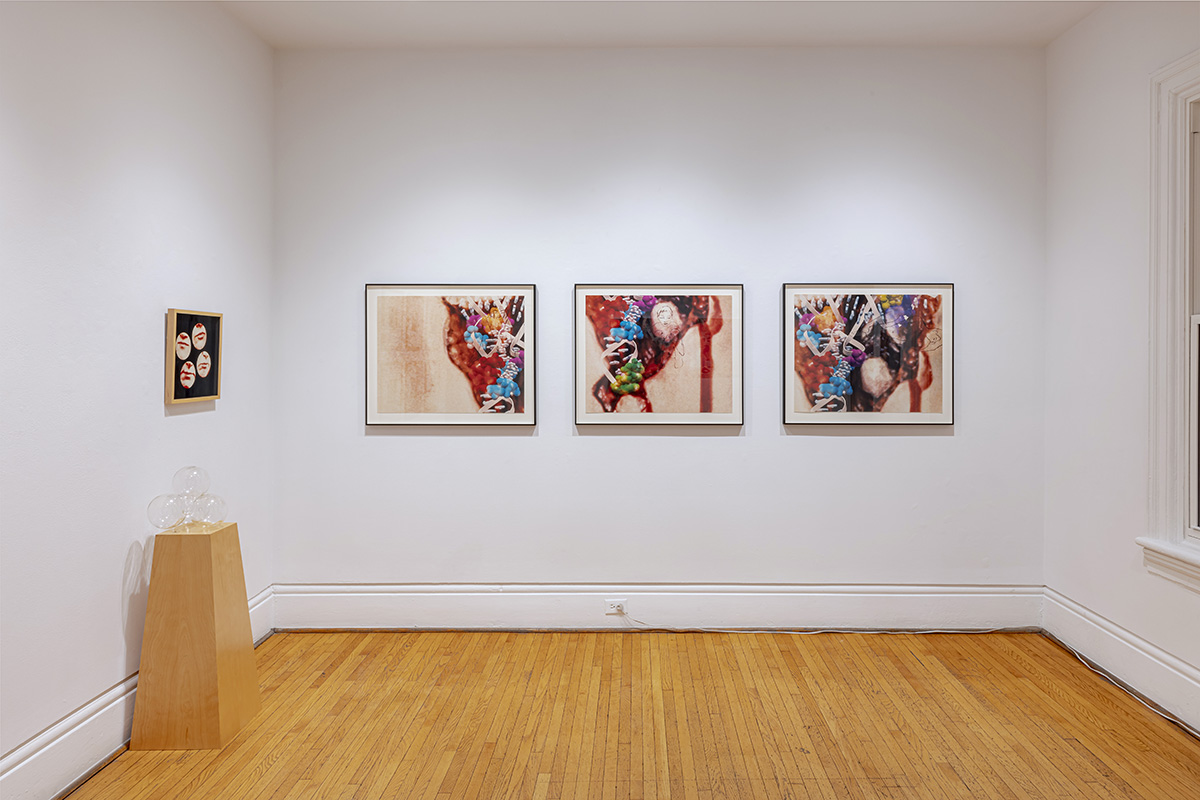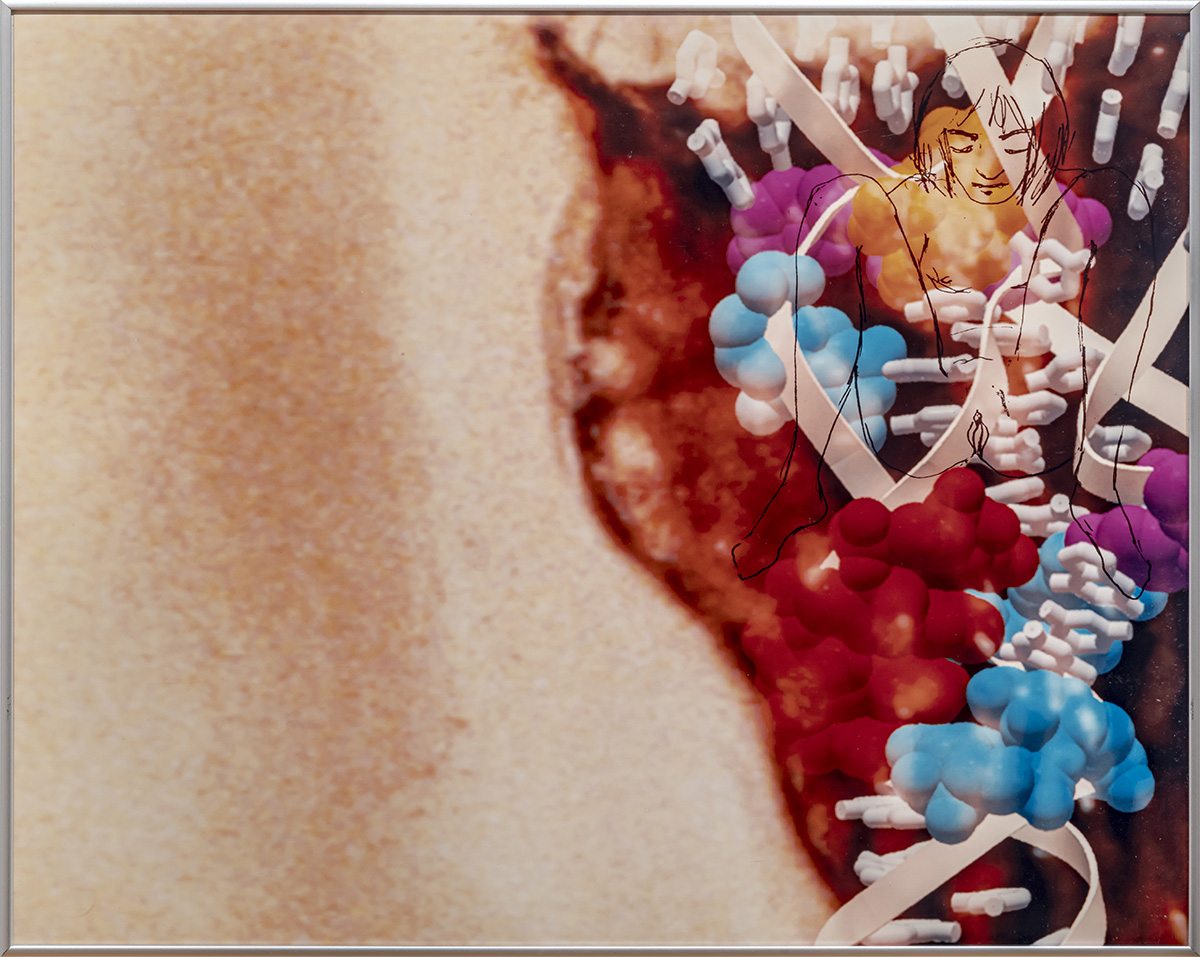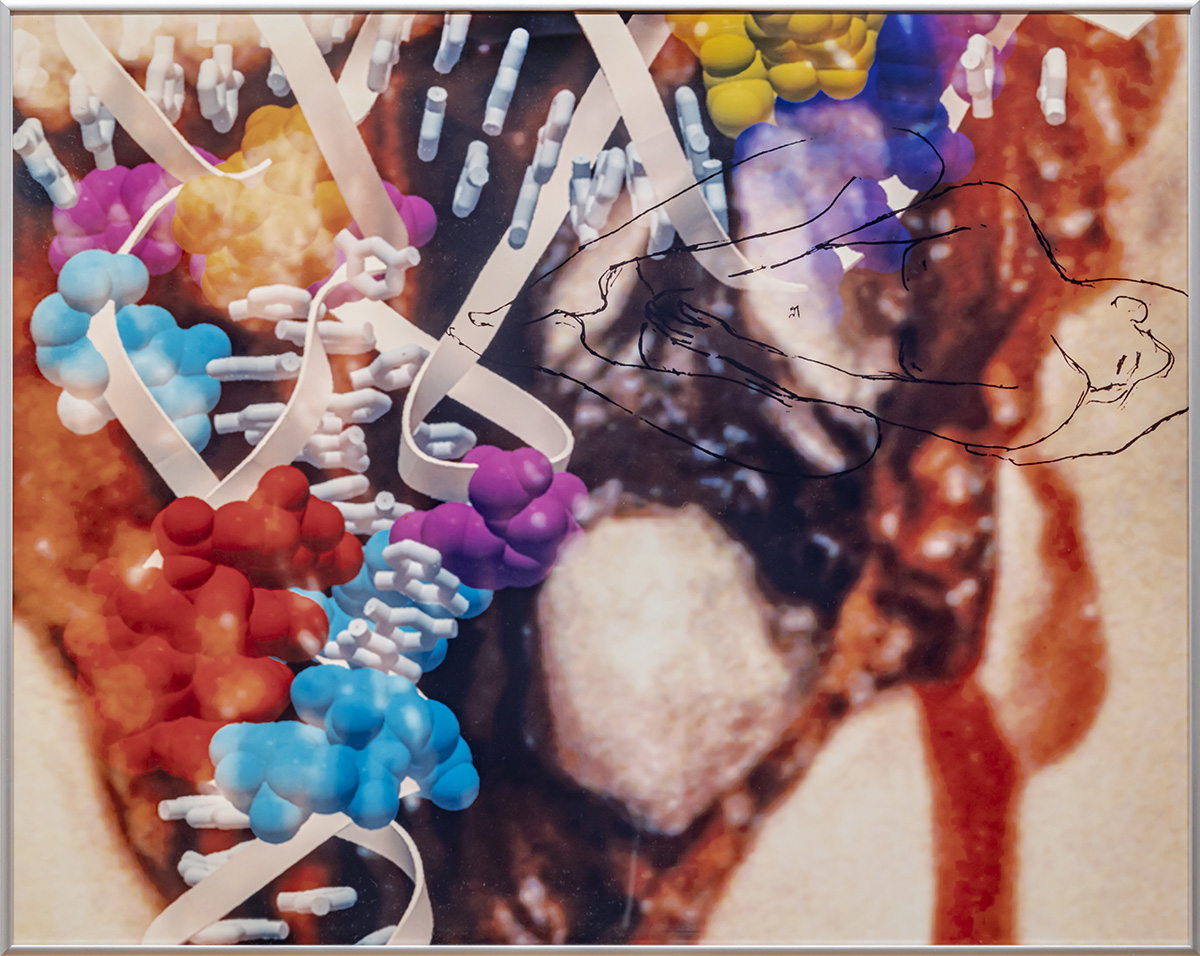You tell me that it's evolution
Nell Tenhaaf
photography and sculpture
February 25 - March 26, 2022

You tell me that it’s evolution
In 1993, not long before these works were made, I wrote an article for C Magazine called Mutational Cravings (see full article below), where I said: “Determinism and reductionism are flourishing as the ideological partners of perfectability in industrial mega-science.” This came out of a longstanding interest in historical science ideas that were marginalized over time, such as the late 17th century vitalism of Wilhelm von Leibniz or more recent research by women scientists that went against the grain of the mainstream, like the work of Lynn Margulis on symbiosis in evolution.
I think that the perfectibility era is definitively on shaky ground with COVID. Because of the pandemic it finally may be dawning on us that we can’t continue to exploit the natural environment to amass wealth or pursue immortality without pushback from the natural world, into our bodies. Holistic is not just a New Age sound bite, it’s a way we need to think.
The photographs Machines for Evolving put the personal and reflective self-knowledge of drawing into the objective science picture. Three different figure drawings are superimposed on a backdrop that consists of various kinds of information about the body: a computer model of t-RNA, and an artificial wound. In relation to our desire for self-knowledge, the three elements as a whole pose the question of how accessible our bodies are to ourselves.
In Expression of Humours and Four-Cell Stage, the idea of four rather messy humours that describe the inner self bumps up against a pristine rendition of cells dividing. These humours go back to very early Western physiological theory, associating temperament with bodily fluids and the elements:
phlegmatic (unemotional) / phlegm / water;
sanguine (optimistic) / blood / air;
melancholic (easily sad) / black bile / earth;
choleric (quick to anger) / yellow bile / fire.
This thinking prevailed into the 18th century and is still familiar today, even if superseded clinically by psychology and psychiatry.
These works helped me push past an adversarial stance toward mega-science and its quest to isolate and bioengineer “master molecules,” in essence a hugely flawed attempt to direct evolution. Let’s remember that imperfect and vulnerable bodies are intrinsically part of the rest of the natural world.
-- Nell Tenhaaf, October 2021
(the following is from C Magazine, issue 36, Toronto, 1993, reprinted with permission, and is available as a read-only pdf at https://cmagazine.com/issues/36/pdf?p=44)
"The biomedical basic-science environment of the 90s can be seen as a scientific "Union", typically spanning the activities of 1. a Genetic Engineering Resource Centre; 2. a Molecular Modepig and Dynamics Laboratory; 3. a Visualization and imaging Center; 4. a Biomedical Signals Processing Laboratory; 5. a Computer Graphics Unit; 6. a Mathematical/BiostatisticaI and ArtificiaI IntelIigence Laboratory."
-- From "Creating an Electronic Environment in the Workplace", IEEE Engineering in Medicine and Biology Magazine, March 1992.
Mutational Cravings by Nell Tenhaaf
[Author's note: Rereading this article that I wrote nearly thirty years ago, I was concerned that it might sound like an anti-science rant. Now is a particularly important time to listen to science. But the article is really about some things that were, at the time, at the edges of mainstream science yet intrinsically part of its cultural impact: quasi-scientific elements in cyberpunk and New Age; and contributions by women that were historically marginalized. It seems important today to recognize similar phenomena that are thought of as parallel to, but not part of, science so as to get a clear picture of what it means to us.]
I'm trying to make sense of contemporary science and its burgeoning technological infrastructure. As an aficionado in this domain, I feel regularly bombarded by specialized information that usually has a science fictiona I and even apocalyptic ring to it. The Armageddon that hovers on this horizon is a compelling update on an old theme, signalling a battle between forces that threaten planetary self-destruction on the one hand and promise a great evolutionary leap on the other. Genetic news in particular leaves me feeling thrilled by its allegorical resonance, but puzzled as to how to integrate it into my own cultural perspective.
Through the current visibility and appeal of two "para-scientific" subcultures, cyberpunk and New Age, I've been reconsidering my position vis-a-vis scientific practices. Cyberpunk is a genre of science fiction that began in the early eighties as an expression of urban punk culture sensitized to the cybernetic hybridizing effects of computer technologies. The genre has spawned a trope that is now widely used, called cyberspace, an enthralling immersive experiential space authored by novelist William Gibson. This fictive construct is frequently described as imperfectly realized in electronic networks and virtual reality interfaces and is thus charged with a sense of futuristic potential. New Age movements in their various manifestations are also tuned to the future, though with less technological obsession. Both cyberpunk and New Age adherents have shown a fascination with the possibilities of genetic mutation, expressing a longing for instant evolution into a higher state of being. To my mind these tropes point to the difficulty of developing an informed, oppositional and also pleasurable position in the face of the power politics of "big science" projects and science as industry. Instead, they describe powerlessness and locate a masochistic pleasure there, in the face of a unilateral history and a daunting structural complexity.
So as to look at the relationship between official science and the marginal cultural groups that surround it, I have two fragments of science history to recount. Each is centred on the permutations of the theories of a scientist who is both hero and father-figure, that is, one whose ideas generated subsequent discoveries still pertinent and in use today. The two figures who occupy the historical centres of my narrative are Baron Gottfried Wilhelm von Leibniz (German, 1646-1716), considered to be a father of thermodynamics, and twentieth century theoretical physicist Erwin Schrödinger (Austrian, 1887-1961), inventor of the quantum wave equation. In the history of science, these physicists each played key roles in the development of biology, the science of life, and consequently, in the birth of genetics and what is known today as biotechnological science.
I'm complicating the official version of science history by reinserting some threads of historical narrative that were pulled away from the writing of modern science because of their "irrationalism." In particular, I'm interested in looking at how remnants of pre-Cartesian organicist scientific worldviews have been taken up by the subcultures of New Age and cyberpunk, in the construction of their own quasi-scientific histories.
Parallel to examining the "alternative" historical roots of cyberpunk and New Age, I'm inserting a feminist revisionist point of view, calling attention to the repeated inscription of the feminine outside of sanctioned science. In the official stories around each of these men there is an erasure of a woman thinker, whose contribution to scientific development was eclipsed until feminism entered the picture in the last decades. This is not to argue that the women should have been the heroes, but that science becomes and remains monolithic in part through the official history persistently ascribed to it.
A philosopher and mathematician, Leibniz is best known for the principle of the conservation of energy. In a conjuncture chat skips over quantum mechanics and its profound philosophical impact on 20th century thought, Leibniz's ideas culminated in both 19th century classical physics with its conception of the mechanical, clockwork ordering of the universe, and in contemporary computer systems logic. Leibniz is a key to Enlightenment philosophy in his development of a binary logical language that he believed guided the workings of the whole universe. The latter idea is taken to be a prototype for computer calculating logic.(1)
Leibniz diverged from Newton, the other cornerstone of classical physics, in that he considered only the phenomenal world to be mechanical and the natural world to be vitalist or permeated with a nurturing and divine life force. He opposed the description of the structure of all matter as the mechanistic atomism which Descartes had proposed earlier in the 17th century, not for its mechanical and mathematical basis but for its contention that atoms are inert and controlled by external forces. Leibniz believed that body and spirit are essentially alike and alive, that they are different forms of the same thing in preestablished harmony. In this he was in tune with, and an avid reader of, Anne Conway, an English vitalist philosopher, whose treatise on the nature of spirit and matter was published posthumously and perforce anonymously in 1690. Carolyn Merchant demonstrates chat the monad, Leibniz's infinitesimal vital active force or "individual substance," is a term that came from Conway. She in turn had developed the idea from her readings of the ancient Cabala texts.(2)
This concept of an intrinsic life force did not inform the discovery of biological building blocks per se, but nevertheless points to and activates the crucial question, "What is life?", that Schrödinger poses more than two centuries later in speculating about the nature of animate matter in an ordered universe. It was scholarly error, brought about by the requirement chat women's names not appear on published texts, that eliminated Conway's role in this key moment of science history.
Vitalist monadology, it would seem, as a theory of immanent forces and of harmony among different aspects of reality, now also serves as a philosophical basis for cyberspace. Gibson characterizes cyberspace as "a consensual hallucination experienced daily by billions of legitimate operators, in every nation ... A graphic representation of data abstracted from the banks of every computer in the human system."(3) On monadology, Leibniz said that "monads have no windows": the monads are related to all other monads in a harmony, but they don't interact or interpenetrate, they mirror each other as well as the universe in a constant state of interdependent animation. These characteristics are interpreted by contemporary philosopher Michael Heim in cyberspace language: "the monad knows through the interface," "monads run different software," and "the Central Infinite Monad, traditionally known as God, ... is the Central System Operator (sysop) who harmonizes all the finite monadic units."(4)
Like many theoreticians of cyberspace, Heim takes electronic networks to be already implanted, if primitive, instances of cyberspace. Although he stops rhapsodizing about merging mondads to sound a humanist lament for organic life energy and "reliable processes of choice" in the all-embracing electronic net, he nevertheless insists on transmuting Leibniz's vitalist metaphysics into a "computer God."(5) His insistence on a centralized authority controlling cyberspace is consistent with Gibson' portrait in Neuromancer of an autocratically controlled social space. Perhaps it should be taken as a happy consequence for women that being written out of scientific history equals being written out of cyberspace. Heim reiterates that bodily and social alienation pervade in cyberspace, at least in its present network version, a feature of on-line communications that many culture critics have commented on.
If Heim is to be taken as emblematic, to what extent is the nascent philosophy of cyberspace reascribing traditional gender dualism and power hierarchies within this new subcultural and marginal construct? One has to ask whether, within such a frame- work, monadology would hold as a cyberspace substrate were it credited equally to Conway as well as reinvested with its historical vitalist roots. Vitalism was first theorized by Paracelsus (Swiss, 1490-1541), an unorthodox populist healer (and charlatan to some). It must be emphasized, as Carolyn Merchant exhaustively traces, that vitalism as Paracelsus practiced it in the sixteenth century was a radical challenge both to medical orthodoxy and later, in the mid-seventeenth century, to the political establishment when it was taken up by dissenting social sects (e.g. English Diggers and Ranters).(6) Nevertheless its key ideas informed Leibniz's propositions on energy and dynamics, and so in relation to scientific practices vitalism has both fringe and mainstream status.
Cyberpunk and New Age are the most visible subcultures that occupy this kind of ambivalent position vis-a-vis science today, mirroring the doubled historical position of vitalism. Springing up as a literary and popular culture genre in the early eighties, cyberpunk claims among its immediate historical roots dystopian sci-fi. But its scientific and literary genealogy also embraces the areas of cybernetics, robotics, and a panoply of fantastical man/machine interface images, from the golem through Frankenstein to the punishment machine in Kafka's In a Penal Colony.(7) In cyberpunk, fusion with an electronic net, or jacking into the matrix in Gibson's terminology, is both sexual and solitary, a masturbatory act that transcends mere body contact. Claudia Springer reads the violence that pervades cyberpunk imagery as fascistic, in that the armoured "machine body" defends the masculine ego against a threat of psychic dissolution.(8) The enhanced cyborg body, not always male but consistently macho, is dependent on prostheses, artificial parts from a highly technological order. Such enhancement permits an illusion of control while encircled in the totalizing net.
In contrast, New Age philosophies teach transcendence through "natural" body-based practices and therapies. These tend to encourage the emergence of the feminine, but in its stereotyped sense of the nurturing and communal half of human nature. New Age adherents have established links with vitalist epistemology by claiming it as one of the historically alternative scientific and medical philosophies that inform their own practices. Vitalism is a self-transformational epistemology that has obvious appeal for New Age thought.
As Andrew Ross points out, New Age meta-physics descends from heretic occult traditions that, in the 18th and 19th centuries, embraced science as a site of opposition to orthodox Christianity.(9) In a peculiar twist of logic, New Age today embraces certain aspects of science, but in opposition to science itself. Paracelsus' vitalism, as a fringe practice, adds a further historical dimension to Ross's proposal that New Age communities of interest are implicitly but ambiguously oppositional in that they use the language and modes of science as legitimation, but offer some extent of self-determination and self-empowerment as an alternative to mainstream institutions.
Controlled merging with the all-powerful matrix becomes in cyberpunk a highly attractive alternative for human contact, with a net result of disengagement. As well, Ross argues that the emphasis on personal growth in New Age disenables a necessary critique of institutions and the social order they maintain.(10) In fact, I would go further and propose that it sets up a kind of looming vulnerability: when a New Ager in a visualization exercise feels cosmic energy flowing through the body and uniting her atoms with the universe, a holistic variation on jacking-in, the conceptual distance from a willed absorption into the institutionally sanctioned biomedical net that already is in place seems a short one. What is happening in biomedical and biotechnological research today is an extension of the computer-based informational net that embraces, in a crude preliminary form, all of the so-called developed world. A significant data space is emerging in this domain, what we might call an embryonic cyberspace or a node in the matrix. While this is not yet a comprehensive data net with I/0 ports - into which we can plug our senses or our most advanced probing equipment - the development of database software and communications protocols in these areas is currently a research priority in the U.S.
This developing net is composed of data banks that contain textual, numerical and visual information pertaining to all aspects of health and body sustenance. The visual material ranges from medical scans converted to 3-D pictures of body parts, to molecular simulations that move in real time, a research area globally called scientific visualization. The bio-statistical information in this net includes already operational genetic databases, such as GenBank and the HGML (Human Gene Mapping Library).(11)
Such a bionet might be potentially vitalist in its minutely detailed and always speculative representation of our physical makeup, that is, infused at every level with the life force. But when we call it by its official tech name, televisualizaton, it raises the spectre of the Baudrillardean hyperreal and cannot simply be seen as an expanding externalized picture of the inner body developed as a medical tool. And certainly it's not implicitly accessible, as the electronic net is conceived by hackers and regular users. In fact, in Baudrillard's terms it would be hyper-hyperreal, because simulation in the domain of biomedicine and biotechnology is no longer just a marker of the collapse of meaning struc- ture, but the tool and the research methodology by which this new, highly specialized picture world is generated.
The scientific tradition of model-building here is refined into the domain of the hyperreal, the tinker-toy molecule becomes a magical rotating multi-dimensional crystal-like entity that simulates the behaviour of a molecule. If we follow Baudrillard's argument in Simulations that the hyperreal implies the installation of a "radical law of equivalence and exchange" where boundaries collapse, especially within representation, this implies an extended loss of referent that is as significant a shift as quantum mechanics signalled in the early part of this century.(12) The ultimate "natural" matrix, our molecular constitution, has already become shifting ground. This is what Gibson conveys so startlingly through cyberspace, what cyberpunk reifies, New Age has visions of, and artists are beginning to articulate: "I move within the semblance of my living body, a simulation of my physical and imaginary experience that is travelling back and forth across my thresholds, taking me away."(13)
Some historical explanation seems called for to situate biotechnology and biomedicine within the framework of twentieth century science, where quantum mechanics dominated until recently as the popular metaphor of choice. The mid-century birth of molecular biology signified a new attention to the puzzle of organic chemistry, and with the parallel meteoric development of computer technologies after the war, "code" began to supplant "particle" as the hot concept.
The ideas that Erwin Schrödinger, a father of particle physics, put forward in his 1944 book What Is Life?, represent a pivotal point in the emergence of the new science of molecular biology.(14) In addressing the problem of how to reconcile the laws of physics and chemistry with the macro behaviour of organisms, in particular the ordered continuity of life through heredity, Schrödinger arrives at the conclusion that the gene molecule functions according to its own internal statistico-dynamic laws. It behaves like a solid, in fact like an aperiodic crystal, accounting for both its order and randomness. It was generally accepted then, as Schrödinger believed, that the gene was a special type of protein molecule, and there was as yet no link to the DNA molecules that X-ray crystallographers were establishing as occurring in the chromosomes. Nevertheless, Francis Crick left physics for biology after reading Schrödinger's book, and subsequently teamed up with biochemist James Watson and a group of crystallographers to work on, and soon solve, the problem of the structure of DNA.
To condense this history tremendously, the unlocking of the DNA code in 1953 ushered in a fabulous new era of biological science, focusing on the manipulation and synthesis of molecular processes. By the early 70s, biotechnology per se was inaugurated with the ability to splice genes through recombinant DNA technology.(15)
The engineering of molecules is what defines biotechnology. High-stakes industrial biotechnology revolves around the astonishing agenda of manufacturing organisms that are better, i.e. more performative, than naturally occurring ones. Its products range from enzymes for waste disposal to microbes that produce better vegetables to designer drugs. Regulatory agencies such as the U.S. National Institute of Health can hardly keep up with the need to set research and industry guidelines. The aggressive competitiveness that drives the industry is a new frontier of capitalist endeavour, a "race that rivals the race into space," to quote one company's brochure.(16) Thus it establishes our contemporary understanding of the historical continuum as a self-willed evolution, not just in terms of a political abstraction but as a flourishing high-tech industry.
Philosophically, what drives this engine is the preeminence of code. This can be sensed already in Schrödinger's fascination with the workings of the gene: "... the power this tiny central office has in the isolated cell (resembles) stations of local government dispersed through the body."(17) The aphorism of the hour is that information is everything and everything is information. Baudrillard's lament for the end of meaning, the implosion of the poles of positive and negative, subject and object, cause and effect, etc., takes this hierarchy as its premise: "It is this gap which vanishes in the genetic coding process, where indeterminacy is less a product of molecular randomness than a product of the abolition, pure and simple, of the relation. In the process of molecular control ... there is no more traversing of an effect ... there is just an implosion of meaning. This is where simulation begins."(18) The image is a daunting one, reminiscent of popular science writer Richard Dawkins' "selfish gene" idea that life is merely a series of instances of the genes' drive to express.
The ultimate, the most fascinating and frightening, effect of this code fixation to date is the Human Genome Project (HGP), the international multi-million-dollar mega-project to map the entire human genetic schema. "The HGP is nothing but the creation of the most amazing database ever attempted - the database containing instructions for building people.” (19) Is this another instance of the hyper-hyperreal, or is it the quest for an ultimate real, for knowledge sensed as necessary or even ontological in the face of "the characteristic hysteria of our time," as Baudrillard puts it? Except that the argument is circular, because an implicit genetic and informational determinism seems to be generating our postmodern panic, the "operativity of information" as Lyotard puts it (in The Postmodern Condition) having replaced the rational search for truth in modernist science. Determinism and reductionism are flourishing as the ideological partners of perfectability in industrial mega-science.
Schrödinger admits to a dilemma about determinism and free will implicit in his "laws of nature" approach to biological functioning. He chooses to circumvent it through recourse to Eastern mysticism, declaring at the end of his book that "consciousness is a singular of which the plural is unknown."(20) New Age has taken up this kind of mystical and levelling aphorism, but not mainstream science. The drive to a patriarchal determinism is a central feature of the code. Informational supremacy in the form of DNA, the Master Molecule, kills every other consideration in the genome project. Criticism of the arguments underpinning the project include complex debates about eugenics, the failure to view database organization as a flawed human collaboration, and biological arguments infused with social analysis about how a whole organism works in concert rather than under the whip of the sysop.(21)
There is a woman written out of molecular biology history as well, X-ray crystallographer Rosalind Franklin, who by all accounts contributed crucial data to the process of solving the structure of DNA and was denied credit for her work. Since Franklin died within living memory, in 1958, an ambivalence surrounds her absence from the group who won the 1963 Nobel Prize (Crick, Watson and Maurice Wilkins, Franklin's co-worker). Should she have pushed harder to publish her own results, a sine qua non of contemporary research? An unpublished paper was used by Watson and Crick without her permission, but in the dog-eat-dog world of research, this is not an unknown phenomenon.
Given this legacy from the early days of DNA, it's not surprising that code, the new keyword, retains attributes of the old familiar monotheism, but in the new language of the sysop or the Master Molecule. The urge to hegemony in this territory is most evident in the similarities and at the same time distance between high-stakes mega-projects like the HGP, and the futuristic agendas of New Age and cyberpunk cultures. Ross summarizes the evolutionary aspirations of New Age as the wish for "... voluntary control over the behaviour of the body's every cell ... ; a good deal of New Age inspiration stems from the perception that the dawning of the Age of Aquarius brings humans the opportunity, for the first time in history, to take control over their evolution hitherto determined
by genetic accident.” (22) New Agers pursue this goal through practices that are seen as updated alchemical processes. Although they can bring about a more integrated sense of self, these practices and desires reflect, but have no effect on, the real propensities of high-tech genetics.
Cyberpunk eulogizes mutated beings as a redemptive force. It suggests, after Timothy Leary's "S.M.I.2L.E. ...Think for yourself ... Escape the gene pools,"(23) that a willed genetic alteration is a result of the drug experimentation of the sixties: "Look at old footage of Woodstock and you wonder: where have all those wide-eyed, ecstatic, orgasm-slurping kids gone? They're all across the land, dormant like deeply buried perennials. But their mutated nucleotides have given us a whole new generation of sharpies, mutants and superbrights, and in them we must put our faith - and power."(24)
The most compelling image of the socioeconomic reality of these para-scientific desires and self-transforming urges, whether holistic, chemical or cybernetic, would require imagining the potential client of a biotech gene improvement clinic of the future. Clinic here would naturally imply a cyberspace architecture, rather than a physical one. In the likely absence of comprehensive health care services in the U.S., this clinic's client would probably not be a cyberpunk. It would more likely be a self-actualized yuppie New Ager looking for somatic fine-tuning, someone who could afford the kind of advanced visualization that the bio cybernet is already producing.
NOTES
1. Leibniz is considered too fundamentalist, too mired in a monistic conception of ultimate forces and essential elements to be pertinent to quantum mechanics. He does, though, converge with the popular theoreticians of twentieth century physics on the notion of the unity and vitality of all aspects of the universe, micro~ and macrocosmic: in each portion of matter there is an entire universe. Also, Leibniz is said to have found in the I Ching a compelling binarist logic that informed his own metaphysics.
2. Carolyn Merchant, The Death of Nature: Women , Ecology and the Scientific Revolution (San Francisco: Harper & Row Publishers, 1980), p. 254.
3. William Gibson, Neuromancer (New York: Ace Books, 1984), p.51.
4. Michael Heim, "The Erotic Ontology of Cyberspace," Michael Benedikt ed., Cyberspace: First Steps (Cambridge, Mass. and London: The MIT Press, 1991), pp. 71-73.
5. Ibid, p. 78.
6. Merchant, op. cit., p. 123. The Diggers were a radical sect that advocated the seizing and cultivation of common lands by the poor. The Ranters believed that God, the "mighty Leveller," would return the earth and its bounty to communal ownership.
7. See Harald Szeemann, ed., Le Macchine Celibi (Venice: Alfieri edizioni d'arte, 1975), p. 25.
8. Claudia Springer, "The Pleasure of the Interface," Screen, 32:3 (Autumn 1991), p. 317.
9. Andrew Ross, Strange Wearher: Culture, Science, and Technology in the Age of Limits (London and New York: Verso, 1991), p. 23.
I0. Ibid, p. 69-70.
11. Presumably run by the U.S. National Academy of Sciences, although this isn't clear in articles in the IEEE Magazine.
12. Jean Baudrillard, Simulations (New York: Semiotext(e), 1983), p. 43.
13. Catherine Richards, Virtual Seminar on the Bioapparatus, Catherine Richards and Nell Tenhaaf eds. (Banff, Alta: The Banff Centre, 1991 ), p. 58.
14. Erwin Schrödinger, \Vhat is Life? (Cambridge: Cambridge University Press, 1967).
15. The controlled modification of DNA molecules so as to insert a new genetic message into a host molecule or microbe.
16. "The New Biology: Monsanto's Perspective on Biotechnology" (St. Louis, Missouri: 1991).
17. Schrödinger, op. cit., p. 79.
18. Baudrillard, op. cit., p. 57.
19. Robert J. Robbins, "Challenges in the Human Genome Project," IEEE Engineering in Medicine and Biology Magazine, March 1992, p. 25.
20. Schrödinger, op. cit., p. 89.
21. Much of the latter work is being done by feminists in science, such as Americans Evelyn Fox Keller and Ruth Hubbard, as well as by mavericks such as Harvard geneticist R.C. Lewontin. These critics take on science historically, epistemologically, philosophically and also in practical terms of its effects on women's well being. Clearly there is a need for feminist critiques of the new biology, along with analyses of the exclusion of many other cultural knowledges from western science and medicine. Women have long been participant in science, but in our enforced invisibility have been blocked from engaging in much needed debates on ethics and standards.
22. Ross, op. cit., p. 33.
23. Timothy Leary, Neuropolitique (Scottsdale, Arizona: New Falcon Publications, 1988).
24. Queen Mu and R.U. Sirius, quoted in Ross, op. cit., p. I63.






























